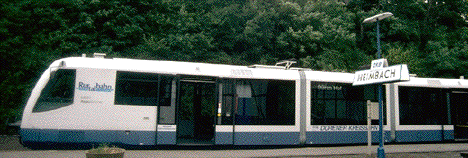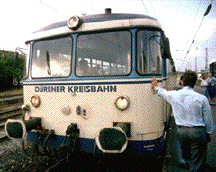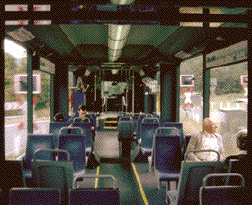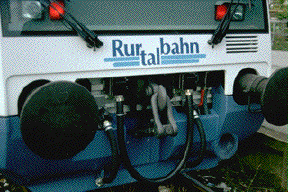Updated April 8, 1997

The RegioSprinter, Siemens-Duewag's new hybrid design that combines the best features of diesel rail cars and low-floor light rail, has now been in revenue service for nearly eight months on two routes of the Dürener Kreisbahn, a publicly-owned line spun off from Germany's federal railway a little over a year ago. The service 30 miles west of Köln has won a lot of local converts but has not yet attracted a significant tourist market, if traffic this past August was any indication.
At least five of the new RegioSprinters had been delivered from the nearby Krefeld-Uerdingen plant. However, a large percentage of runs were still being made with the old mid-50's schienenbuses, a rather primitive bus on rails with styling reminiscent of its contemporary, the VW microbus.
On the DK's hourly service between Düren and Jülich, a run through mostly flat, semi-urbanized terrain, the RegioSprinters had mostly taken over. On the hourly south line linking Düren and Heimbach, a less populous but more scenic trip, a pair of three-car sets of schienenbuses still handled the heaviest-demand departures.
Riding the old cars, then the new, it was hard to believe that the two were on the same piece of railway. The schienenbuses on the hill-and-dale Düren-Heimbach line clearly display the track's every joint, dip, jog, and cross-level problem, especially at the frequent grade crossings.
 Schienenbuses look like old VW's.
Schienenbuses look like old VW's.
By contrast, the double-articulated RegioSprinters make the track feel almost like continuous welded rail. The new cars lack the shimmy that sometimes occurs on articulated cars with their short body sections, and showcase the line's scenery with their huge windows.
Interior fittings are designed with a wide variety of passenger traffic in mind. Bicycles, baby carriages, and wheelchairs have easy access at the low doors. Areas around the doors are fitted with fold-down perimeter seating, bicycle hooks, wheelchair tiedowns, and standee straps for maximum flexibility.
 Big
windows show off scenery.
Big
windows show off scenery.
The Dürener Kreisbahn is a homespun operation, and not really used to major tourist traffic. Accordingly, there are a few rough spots with signage and marketing. At Düren, it is somewhat difficult to identify the locations of Kreisbahn departures, since DB did not incorporate these into their list. The DK's main list is outside on the east side of the station, but confusion is amplfied by the fact that the Kreisbahn uses four different platform locations, not all well signed, and has adopted the marketing name of the Rurtalbahn. The new cars are signed with both names.
 2
names, 4 platforms.
2
names, 4 platforms.
Adventuresome rail tourists who want to try out the new trains have easy access to Düren from Köln. Passengers who miss their connection at Düren may find the Stehcafé Hubert Hermann in the station a hospitable refuge, as it offers three taps, Düsseldorfer favorite Diebels Alt, Köln's Gaffel Kölsch, and Bitburger Pils.
The south line's scenery becomes most interesting south of Kreuzau, where the Rurtal tightens up and the line starts curving. Woods and fields alternate with camping grounds and small villages for the next ten miles. Heimbach, the most tourist-oriented destination on the route, offers a variety of hotels, motels, and restaurants. Heimbach also has a choice of two nature trails leading to the Rursee, which features a round-the-lake boat service April to October, hourly May to September.